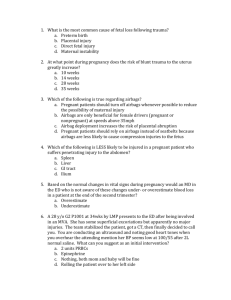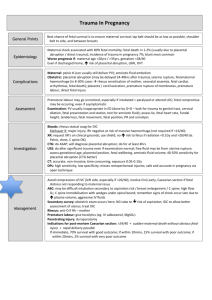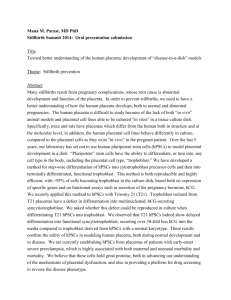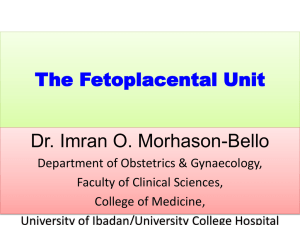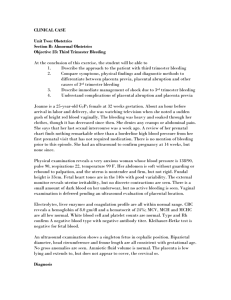OB_Case-Graham
advertisement
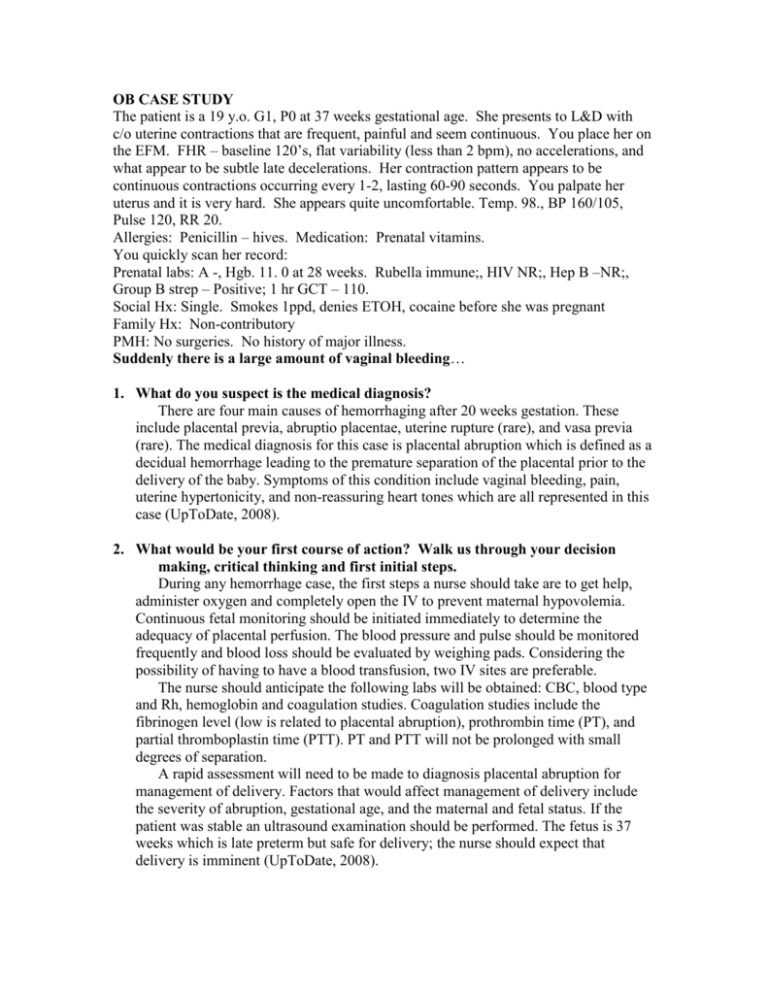
OB CASE STUDY The patient is a 19 y.o. G1, P0 at 37 weeks gestational age. She presents to L&D with c/o uterine contractions that are frequent, painful and seem continuous. You place her on the EFM. FHR – baseline 120’s, flat variability (less than 2 bpm), no accelerations, and what appear to be subtle late decelerations. Her contraction pattern appears to be continuous contractions occurring every 1-2, lasting 60-90 seconds. You palpate her uterus and it is very hard. She appears quite uncomfortable. Temp. 98., BP 160/105, Pulse 120, RR 20. Allergies: Penicillin – hives. Medication: Prenatal vitamins. You quickly scan her record: Prenatal labs: A -, Hgb. 11. 0 at 28 weeks. Rubella immune;, HIV NR;, Hep B –NR;, Group B strep – Positive; 1 hr GCT – 110. Social Hx: Single. Smokes 1ppd, denies ETOH, cocaine before she was pregnant Family Hx: Non-contributory PMH: No surgeries. No history of major illness. Suddenly there is a large amount of vaginal bleeding… 1. What do you suspect is the medical diagnosis? There are four main causes of hemorrhaging after 20 weeks gestation. These include placental previa, abruptio placentae, uterine rupture (rare), and vasa previa (rare). The medical diagnosis for this case is placental abruption which is defined as a decidual hemorrhage leading to the premature separation of the placental prior to the delivery of the baby. Symptoms of this condition include vaginal bleeding, pain, uterine hypertonicity, and non-reassuring heart tones which are all represented in this case (UpToDate, 2008). 2. What would be your first course of action? Walk us through your decision making, critical thinking and first initial steps. During any hemorrhage case, the first steps a nurse should take are to get help, administer oxygen and completely open the IV to prevent maternal hypovolemia. Continuous fetal monitoring should be initiated immediately to determine the adequacy of placental perfusion. The blood pressure and pulse should be monitored frequently and blood loss should be evaluated by weighing pads. Considering the possibility of having to have a blood transfusion, two IV sites are preferable. The nurse should anticipate the following labs will be obtained: CBC, blood type and Rh, hemoglobin and coagulation studies. Coagulation studies include the fibrinogen level (low is related to placental abruption), prothrombin time (PT), and partial thromboplastin time (PTT). PT and PTT will not be prolonged with small degrees of separation. A rapid assessment will need to be made to diagnosis placental abruption for management of delivery. Factors that would affect management of delivery include the severity of abruption, gestational age, and the maternal and fetal status. If the patient was stable an ultrasound examination should be performed. The fetus is 37 weeks which is late preterm but safe for delivery; the nurse should expect that delivery is imminent (UpToDate, 2008). 3. What is the pathophysiology of this condition? The rupture of the maternal vessels in the decidua basilis where they meet with the anchoring villi is often the cause of abruptio placentae (See figure 1). Rarely, it originates from the fetal-placental vessels. The blood that accumulates splits the decidua with the placenta from the uterus. The bleeding can result in a small separation or a complete placental separation from the uterus. Separation of the placental from the uterus limits the exchange of gas and nutrients compromising the fetus. A patient who presents with acute abruption usually presents with vaginal bleeding, pain, and uterine attractions. Occasionally the hemorrhage can be concealed as the blood can be trapped between the fetal membranes and the decidua. When the abruption is severe (>50% separation), fetal and maternal compromise can occur. DIC develops because the blood is exposed to large amounts of tissue factor and there is a massive generation of thrombin triggering coagulation. Manifestations of DIC include bleeding, shock, kidney, liver, lung, and nervous system dysfunction, and thromboembolism. If the abruption is a chronic process, the patient presents with chronic and intermittent bleeding and may have oligohydramnios, fetal growth restriction, and/or preterm rupture of the membranes. Diagnosis of placental abruption can made through an ultrasound; a retroplacental clot is a classic ultrasound description of placental abruption. Laboratory tests indicating coagulopathy may support the diagnosis. Placental abruption complicates 1 in 100 births, with severe abruptions resulting in stillbirth occurring in 1 in 830 deliveries. Incidence of placental abruption is more likely at 24-26 weeks. The U.S. is seeing an increase in the incidence with the increase in women with gestational diabetes, preterm labor, and short umbilical cords among black and white women. Risk factors for placental abruption include mechanical trauma, hypertension, preterm rupture of the membranes, placental disease (underperfusion, hypoxia, ischemia), cocaine use, and cigarette smoking. Maternal complications include hypovolemia related to blood loss, need for blood transfusion, DIC, renal failure, respiratory distress syndrome, multisystem organ failure, and/or death. Fetal complications include growth restriction (chronic abruption), hypoxemia or asphyxia, preterm birth, and/or death (UpToDate, 2008). 4. What would you anticipate the medical orders to be? Anticipate labs will be ordered: CBC, blood type and Rh, hemoglobin and coagulation (fibrinogen level, prothrombin time (PT), and partial thromboplastin time (PTT)). Anticipate blood/blood product replacement for: -Hematocrit below 30% give packed RBCs -Severe thrombocytopenia (<20,000uL) or moderate thrombocytopenia (<50,000uL) give platelets -Fibrinogen <150mg/dL give plasma Management of near term fetus with placental abruption: The fetus should be delivered by the safest and quickest method of it is alive and at least 34 weeks. If maternal status is stable and the fetal heart tracing is reassuring, vaginal delivery is reasonable. Because she is in active labor, no Pitocin will need to be given, but an amniotomy should be performed to quicken the process. If the fetal heart tones are non-reassuring, major blood loss, and maternal status is unstable, then a cesarean section is indicated. C-section in the presence of coagulopathy places the mother at a higher risk for morbidity or mortality. If not possible to correct the coagulopathy, have blood, plasma, platelets, and cryoprecipitate available in the OR. Because a women with placental abruption has a higher risk of postpartum hemorrhage, IV Pitocin and an uterotonic agent such as (methergine, Hemabate) should be administered after the delivery of the placenta. If fetal demise has occurred, mode of delivery should be that which minimizes the risk to the mother. Vaginal delivery is preferred unless urgent delivery is needed to stabilize the mother. 5. What medications might be used? Maternal medications: Oxygen Blood and/or blood products Prophylactic IV Antibiotics for GBS + (consider Penicillin allergy) IV Pitocin and uterotonic agents (methergine, Hemabate) post delivery Pain Medications: epidural or spinal Anesthesia for c-section (if code c-section, more common to use general anesthesia) Fetal medications: HepB vaccine immediately after birth since no results for mother, Vit K injection, Erythromycin eye prophylaxis Figure 1: Placental Circulation References Lin, Y.E. (n.d). Feeding the Baby: The role of the Placenta During Pregnancy. Retrieved on November 23, 2008 from http://www.sciwrite.caltech.edu/journal03/A-L/lin.html/ UptoDate (2008). Clinical features and diagnosis of placental abruption. Retrieved on November 23, 2008 from http://www.utdol.com/online/content/topic.do?topicKety=pregcomp/7939 UptoDate (2008). Management and outcome of pregnancies complicated by placental abruption. Retrieved on November 23, 2008 from http://www.utdol.com/online/content/topic.do?topicKety=pregcomp/31354


